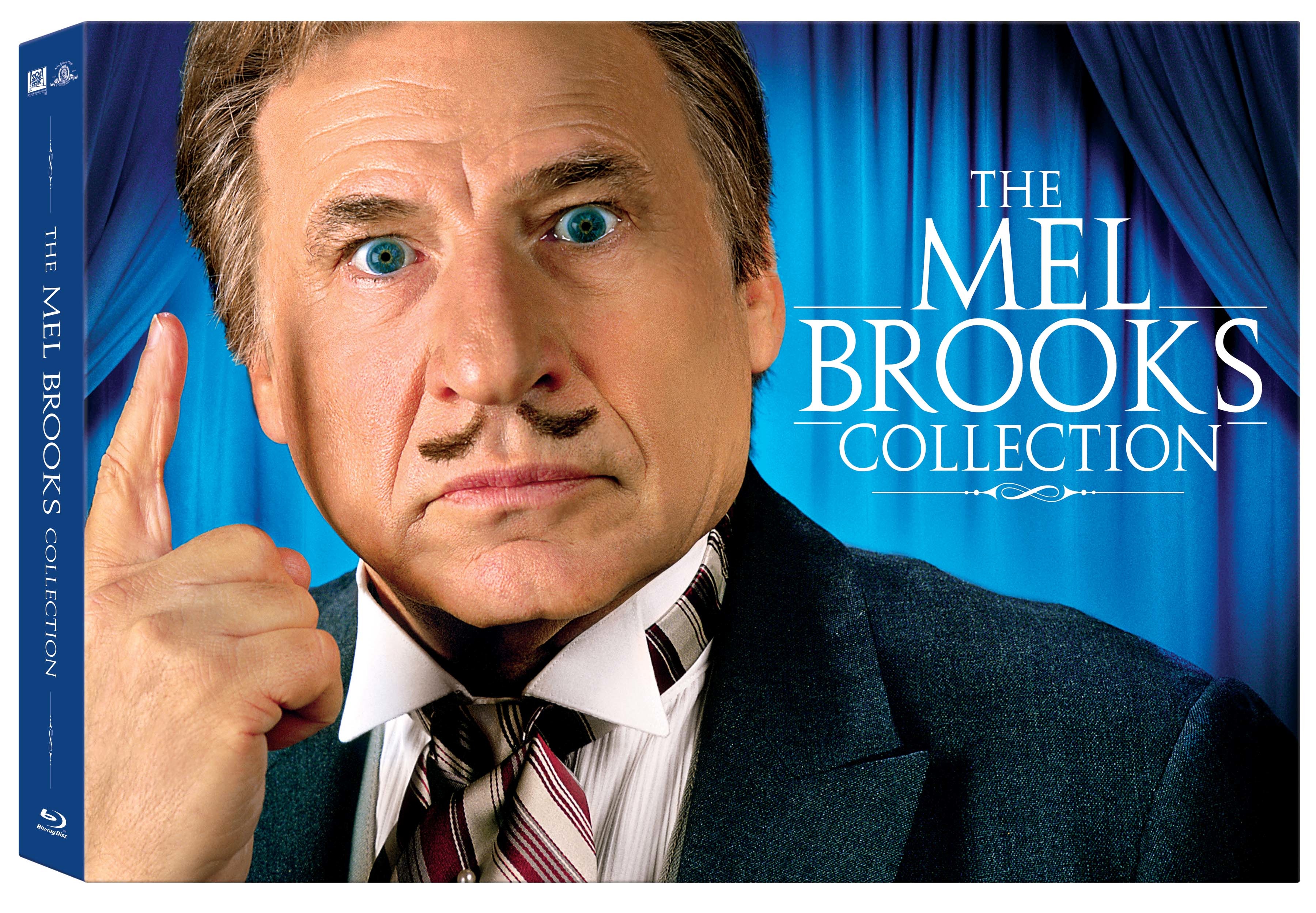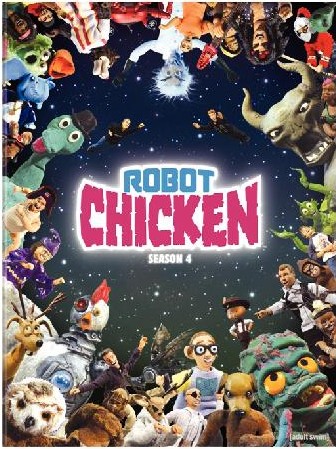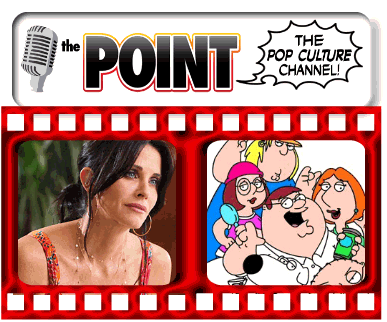Wolverine as you’ve never seen him before

I’ve been looking for some place to use this image for a loooong time, and I’m tired of waiting.
Think of it as a magic of Christmas thingie.
Consider this an open thread.

I’ve been looking for some place to use this image for a loooong time, and I’m tired of waiting.
Think of it as a magic of Christmas thingie.
Consider this an open thread.
 A series of films based on a wildly popular series of books walks the tricky line between total fidelity to appease the fans and making the hard choices to create a successful movie-going experience. The vast majority of your audience, the filmmakers presume, have read the source material and/or seen the previous films in the series, so can take for granted that much of the backstory is understood, negating the need for extensive crawls, flashbacks, or expository scenes.
A series of films based on a wildly popular series of books walks the tricky line between total fidelity to appease the fans and making the hard choices to create a successful movie-going experience. The vast majority of your audience, the filmmakers presume, have read the source material and/or seen the previous films in the series, so can take for granted that much of the backstory is understood, negating the need for extensive crawls, flashbacks, or expository scenes.
Harry Potter and the Half-Blood Prince was released to its eager audience in 2005, but moviegoers had to wait four years before the film version was released. This film opened two years after the last film so the trick for director David Yates was in knowing how much needed refreshing for the audience. After all, some of us read the book only once; others may only know the film version. The movie, now available on DVD from Warner Home Video, makes a large number of alterations from the book and also fails to properly place the film in context; Yates expects too much recall from his audience. As a result, the brewing war between the forces of good and Lord Voldemort isn’t as front and center as it should be and his agents of darkness are barely named let alone given anything to do.
Similarly, Yates short-changes the supporting cast as Maggie Smith’s McGonagall and Robbie Coltrane’s Hagrid, for example, are little better than window dressing. He chose, instead, to focus on the teen heartthrob storyline showing the raging hormones now coursing through our heroes’ veins. The relationship between Harry and the poor, doomed Dumbledore, is the second storyline and intertwined they’re good stories, but lacks the full scale and spectacle of the book or previous films. An underdeveloped third thread is the evolution of Draco Malfoy, now a Death-Eater and he fumes his way through the film, feeling too important to remain at Hogwarts but assigned there and when called to deliver the killing blow to the wizard, finds himself conflicted. In many ways the relationship between Draco and Snape and that of Harry and Prof. Slughorn should have been the counterpoints to the film but its an opportunity missed.
The one thing he does get right is the look and feel of impending doom. Each book got more sophisticated in its plotting and characterization, reflecting the maturation of the Hogwarts students, while also growing more malevolent in tone. This film is bleaker looking than the previous quintet, the colors muted and washed out – even joyous scenes such as the Quidditch match, are somber in appearance. You just know things are not right.
Since the move opened this summer, there has been much complaining about liberties taken and favorite scenes removed. It’s been the most grumbling since the series began and as each book has grown in size, adapting the tale for the screen has proven troubling. While the final book is being split into two films and released relatively close together, one wonders if the same should not have been done here, and treat the films as more of a linked miniseries, which seemed to work, after all for [[[Lord of the Rings]]].
The film can be purchased for home viewing in a variety of formats from a standard single-disc DVD with no extras, to a 2-Disc Digital Copy Special Edition which offers up a bunch of extras made largely for its younger audience and not fans of filmmaking. There are six and a half minutes of additional scenes, none of which would have changed the comments above. You can then enjoy the nearly thirty minute Close-Up with the Cast and Crew of Harry Potter special, which is a light look at a day on the set. Better is the 50 minute-long J.K. Rowling: A Year in the Life, which gives the series creator her due. Other extras are playful ones with the cast and an unnecessarily long look at Universal’s “The Wizarding World of Harry Potter”.
Batman: Arkham Asylum was one of the best games of 2009. Only four months after its release, Rocksteady and DC Comics are already giving us a teaser trailer and a new website for the sequel.
Color me excited, but aren’t we at least a couple years away from a sequel?
 I first encountered Mel Brooks’ work, without realizing it, when I began watching [[[Get Smart]]], the wonderful spy satire he cocreated with Buck Henry (who just happened to be my father’s college roommate – small world and all that). It wasn’t until [[[Blazing Saddles]]] and being in high school before I could put a name to the madman who unleashed these wonderful works. From that point on, when I saw his name I was guaranteed to be there.
I first encountered Mel Brooks’ work, without realizing it, when I began watching [[[Get Smart]]], the wonderful spy satire he cocreated with Buck Henry (who just happened to be my father’s college roommate – small world and all that). It wasn’t until [[[Blazing Saddles]]] and being in high school before I could put a name to the madman who unleashed these wonderful works. From that point on, when I saw his name I was guaranteed to be there.
In time, I learned of Brooks’ career prior to Get Smart and understood the steps taken that led to the work that I adored. My respect for his determination as a writer, performer, and romancer only grew with time and understanding. There was no single style to his humor – it could be slapstick, word play, satire – and he blended it unlike anyone previously. Nothing was sacred and he continually pushed the boundaries until he burst past them in 1974 and never looked back.
When he left television for feature films and came up with the hilarious [[[The Producers]]], it seemed the longer form was equally suited to his madcap humor. He followed that with the underappreciated [[[The Twelve Chairs]]] and that was followed by Blazing Saddles, which as we all know, forever changed the rules for comedy. The film though, also derailed Brooks to a degree.
Rather than tell comedic stories, he embarked on a series of satires leaping from one genre to another with great success. Still, it wasn’t until he and his wife Anne Bancroft teamed for [[[To Be or Not to Be]]] did Brooks return to a straight comedy. And then he went back to satires until it was time to recycle his works for Broadway.
His career trajectory is handsomely available in a nine-disc Blu-ray box set, The Mel Brooks Collection
, being released Tuesday from 20th Century Fox Home Entertainment. The discs — [[[Silent Movie]]],[[[ History Of The World Part 1]]],[[[ High Anxiety]]], To Be or Not to Be, The Twelve Chairs, Blazing Saddles, [[[Young Frankenstein]]], [[[Spaceballs]]], and [[[Robin Hood: Men In Tights]]] — come in an 11” x 8” book, paired with a 120-page hardcover book celebrating his career.
TV fans and critics alike were pretty vocal when ABC announced a revamped SCRUBS was headed back to prime time. Series creator Bill Lawrence gives us the frank answers on why that decision was made, plus a little news about CLONE HIGH (remember that?) Meanwhile. Marc Guggenheim is looking for some ACTION and Katee Sackhoff joins the world of comic professionals.

PRESS THE BUTTON to Get The Point!
And be sure to stay on The Point via ![]() , RSS, MyPodcast.Com or Podbean!
, RSS, MyPodcast.Com or Podbean!
Follow us now on  and
and  !
!
Don’t forget that you can now enjoy THE POINT 24 hours a Day – 7 Days a week!. Updates on all parts of pop culture, special programming by some of your favorite personalities and the biggest variety of contemporary music on the net – plus there is a great round of new programs on the air including classic radio each night at 12mid (Eastern) on RETRO RADIO and COMICMIX’s Mark Wheatley hitting the FREQUENCY every Saturday ay 9pm.
CLICK HERE TO LISTEN LIVE FOR FREE or go to GetThePointRadio for more including a connection for mobile phones including iPhone & Blackberrys

Superheroes die. It’s one of their best tricks – dying, tragically, to stop the Big Bad from doing whatever it is he’s doing. Luckily, another one of their best tricks is to come back from the dead – which they need to do, of course, since someone needs to star in their monthly comics, and you can’t let Jean-Paul Valley or John Henry Irons have the spotlight for all that long. (No one would stand for that.)
Batman died recently, more or less. (It’s always “more or less” when a character like Batman dies. Complication cling to them like barnacles.) And these are two of the books in which he did, or didn’t, die:
Batman: Whatever Happened to the Caped Crusader?
Written by Neil Gaiman; Pencils by Andy Kubert
DC Comics, July 2009, $24.99
Gaiman is a powerful and original writer, but he’s also drawn, again and again, to pastiches and homages, to working in the tradition or shadow of previous stories and creators. Even when he describes his original work, one will be the “Lafferty story,” or (more than once) a Lovecraftian tale. And so Gaiman’s Dead Batman story is explicitly the Dead Batman story of all of his favorite comics creators, influenced by Dick Sprang, Jack Burnley, Gardner Fox, Dennis O’Neil and everyone else. Gaiman’s introduction to the fancy-pants collected edition explains this; his very sensible starting point was that Batman will be dead and alive multiple times in his history, and that he (Gaiman) wanted to write a Dead Batman story that would transcend this particular death to be the Platonic ideal of the Dead Batman story, one that would apply to any Batman of past or future, dead or alive.
At the same time, “Whatever Happened to the Caped Crusader?” was conceived to be the Batman equivalent of Alan Moore’s 1986 tombstone to the Silver Age Superman, “Whatever Happened to the Man of Tomorrow?” – a two-issue story, published in the “last issues” of the character’s two iconic titles, before the decks were cleared for a major revamp. (Or, in Batman’s case, an extended absence due to temporary death.) But when Moore took on the end of Superman, revamps were a rarer and more tentative thing – superhero comics characters changed costumes and some life circumstances (married, team, solo, outcast, criminal, etc.), but hadn’t yet taken up the modern round of radical origin changes and multiple deaths on a seasonal basis. Moore had the benefit of novelty, and of being there at the right time – the Silver Age had ended, so he was able to eulogize it. Gaiman has no such advantages; no one would want an eulogy for the current era of mainstream comics, and it hasn’t even had the good grace to die.
But Gaiman does his best with what he has, and what he has is primarily Batman’s supporting cast. Batman has perhaps the best and most recognizable crew of villains in long-underwear comics – plus a fair number of sturdy supporters on the heroic side – and Gaiman lets each of them have their turn in the spotlight. What Gaiman has done in “Whatever Happened to the Caped Crusader?” is what DC probably expected, and what Gaiman has done often – perhaps too often, as it’s getting to be a stylistic tic – to tell a story about stories, a story made up of stories, a Rashomon of comics that adds up to that Platonic Dead Batman story Gaiman was aiming for. So a Golden Age Catwoman explains how Batman died, and then Alfred tells a very different story, and then Gaiman, getting into the second half of his tale, sketches quickly the outlines of a dozen other characters’ versions of Batman’s death. It’s The Wake all over again, or yet another cry of “the King is dead; long live the King!”
Behind and above that – first as a pair of off-page narrators, and then coming onstage in the second half – is a conversation between Batman and a mysterious female figure (luckily, not the one that we immediately suspect), which leads into Gaiman’s version of the core mythology of Batman towards the end of the story. It does not quite edge into metafiction – does not exactly imply that Batman is a comic-book character who will continue to have adventures, to win and lose and die, over and over again – but Gaiman does nod in that direction. It gets rather more Moorcockian than one would have expected, but it all makes sense during the reading.
And, at the end, Gaiman once again appropriates someone else’s work of fiction – I guess I can call it fiction – though he either didn’t get permission to use it explicitly or didn’t want to be that on-the-nose with the real thing. Whatever the explanation, if you grew up in North America in the last seventy years, I expect you’ll recognize it. And so Gaiman is here attempting to tell an emotionally-based story about one seventy-year-old corporately-owned character by using a parallel with a sixty-year-old book also owned by someone else. It’s a nice conceit, reinforcing his Batman-as-Eternal-Champion motif, but it also tends to pull even tighter the Ouroboros of superhero comics – that all references, and all supposedly “new” ideas, are versions and re-imaginings of thoughts that our grandfathers had. “Whatever Happened to the Caped Crusader?” is an excellent Dead Batman story, but – given that Batman and his ilk will never stay dead – one does have to question why we need to keep adding to the endlessly proliferating, self-referential taxonomy of Batman Stories to begin with.
The book Whatever Happened to the Caped Crusader? is filled out with a few sketchbook pages from Andy Kubert – I didn’t mention him above, because he’s the Grace Kelly in this book, doing everything impeccably without ever calling attention to himself, following Gaiman’s lead at all times – and with four shorter Batman stories from earlier in Gaiman’s career. Those stories don’t aim as high as “Whatever” does, and are more successful and more frivolous – a quick look at Batman and the Joker in the green room of comics, origins of Poison Ivy and the Riddler, and a framing story attached to that Riddler story. The Poison Ivy story, in particular, shows what Gaiman can do when given the freedom to invent and not hobbled by expectations and requirements.
I doubt Gaiman’s “Caped Crusader” will ever match the iconic status of Moore’s “Man of Tomorrow,” but attempts to match earlier achievements usually do fall short, so that’s only to be expected. As a classy, evergreen Dead Batman story, it’s about as good as we could expect.
 I don’t know how I missed [[[Robot Chicken]]] when it debuted several years back. I heard the buzz, I saw the ads in the comics and still, I somehow never got around to watching. When the Cartoon Network sent over their second [[[Star Wars Special]]] for review, I finally indulged and was delighted.
I don’t know how I missed [[[Robot Chicken]]] when it debuted several years back. I heard the buzz, I saw the ads in the comics and still, I somehow never got around to watching. When the Cartoon Network sent over their second [[[Star Wars Special]]] for review, I finally indulged and was delighted.
Now, they sent over the two-disc set collecting the complete fourth season, which goes on sale Tuesday, and watched with great delight. The season, which ran from December 7, 2008 through December 6 (last week!), has 20 episodes and the set also includes [[[The Robot Chicken Full-Assed Christmas Special]]].
The show is a riotous tour through the pop culture zeitgeist, presuming the viewers know the players from Tila Tequila to the torturous relationship between Thor and Loki. Many of the episodes are loosely connected vignettes while others feel entirely like a collection of whatever was finished in time got included. When handling a single theme, such as Christmas or [[[[Star Wars]]], they manage to make that work as well, with a broad array of talents coming together to keep things loose and very, very funny.
To me, many of the funniest bits shows the before or after events from favorite scenes such as the natives building the temple deathtraps we saw Indiana Jones avoid in [[[Raiders of the Lost Ark]]] or the day in the life of Jason Voorhees.
Seth Green and Matthew Senreich have certainly developed an eclectic following which has allowed them to bring onboard writers and performers to work with them. In fact, one of the best Video Blogs included in the Extras shows the range of actors who come in and let loose. I can’t decide who was having more fun, Billy Dee Williams or Katee Sackhoff. Among the writers to contribute, beyond the usual suspects from previous seasons is comic book darling Geoff Johns.
Back during [[[Star Trek]]]’s 20th Anniversary, there was talk of an Opera which was partially written before wiser heads canceled the project. But, thanks to one bit, we have a good idea of what it would have sounded like. The hysterical [[[Star Trek II: The Opera]]] is one of the highlights.
No, not every bit works and some episodes feel wildly uneven, but in
each episode I find myself laughing out loud at the absurd
juxtaposition of elements or seeing revered icons poke fun at
themselves.
No one and nothing is sacred to these creators so[[[ Babar]]], [[[Hannah Montana]]], [[[James Bond]]] and just about everyone else you’ve grown up with is fair game. The DVD presents the episodes without censorship so there’s additional graphic violence, nudity and many instances of foul language.
In addition to the 21 episodes, there are Chicken Nuggets (the creators offer commentary), appearances at 2008’s Comic-Con International and 2009’s New York Comic-Con plus when the team promoted the show across Australia. There are way-too-brief Day in the Life glimpses at the many talented technicians who take the wacky scripts and bring them to life. There are a handful of deleted scenes with introductory material to explain how anything manages to get cut plus deleted animatics, early tests showing how a script might look. If you like, the show, these Extras continue the entertainment and are commended to your attention.
They are the architects of some of the funniest moments on TV from COUGAR TOWN and SCRUBS to FAMILY GUY and THE CLEVELAND SHOW, Bill Lawrence and Seth McFarlane share a look into their creative process plus DC digs back again, GLEE goes out with a bang and Nic Cage stars as Mickey Mouse!

PRESS THE BUTTON to Get The Point!
And be sure to stay on The Point via ![]() , RSS, MyPodcast.Com or Podbean!
, RSS, MyPodcast.Com or Podbean!
Follow us now on  and
and  !
!
Don’t forget that you can now enjoy THE POINT 24 hours a Day – 7 Days a week!. Updates on all parts of pop culture, special programming by some of your favorite personalities and the biggest variety of contemporary music on the net – plus there is a great round of new programs on the air including classic radio each night at 12mid (Eastern) on RETRO RADIO and COMICMIX’s Mark Wheatley hitting the FREQUENCY every Saturday ay 9pm.
CLICK HERE TO LISTEN LIVE FOR FREE or go to GetThePointRadio for more including a connection for mobile phones including iPhone & Blackberrys
 Patrick Nielsen Hayden at Tor.com reminds us that on December 11, 1929, the world’s first
Patrick Nielsen Hayden at Tor.com reminds us that on December 11, 1929, the world’s first
club devoted to science fiction met for the first time in a Harlem apartment. They called
themselves the Scienceers and within three years would count Mort Weisinger and Julius Schwartz among their members, along with the original Ray Palmer. Years later, in 1961, one of their original
number recalled those days in a fanzine article which can be read here.
And within a year, there was already a schism in the group, starting a tradition that continues to this very day.